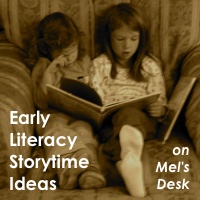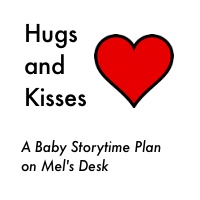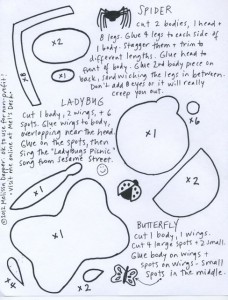A reader recently asked this question: “I love the idea of including early literacy tips in my storytimes but I feel a little preachy when I do. Any suggestions (from anyone) on how to do this?” (Great question, Laura, thank you!)
I am hoping everyone will weigh in with their own thoughts! I will jump in and start the ball rolling with mine!
My library began delivering early literacy messages to parents and caregivers in 2008. We used the six early literacy skills from the first edition of Every Child Ready to Read as our focus, and highlighted one of those skills every month. The second edition of Every Child Ready to Read introduced the five practices parents can do with their child to build those six skills. So now we’ll be highlighting one of those practices every month in storytime: reading, writing, singing, talking, and playing.
I’ve been in a training role for storytime providers at my library for several years now, and I started to “test drive” our early literacy messages before we rolled them out for the rest of the staff. I mention this just to let you know I’ve been delivering a message to grownups in every storytime I’ve presented for almost five years now…I’ve had a little practice! I’ve also talked with a lot of storytime providers and trainers and mentors about what they have found easy and hard about presenting early literacy messages in storytime.
Based on all those conversations and my own trial and error, here’s my advice:
Own Your Role
Whether you personally have 20 years of professional experience or have been a para for 6 months, once you put on a library nametag you are seen by your community as an expert on books and reading. Or at least, people will assume you are more-expert-than-the-guy-at-the-bank, or more-expert-than-the-yoga-teacher. So go ahead and own this role. Just like the guy at the bank, you have specialized information that will make someone’s life easier! Feel confident that what you have to say is important and that you will be respected for your expertise.
Know Your Stuff
Even if you are just starting to learn about early literacy and how children get ready to read and you feel like you don’t know very much (or understand very much), don’t let that shake you. Take it step by step and learn a piece at a time. When you feel comfortable with an idea–when you can put it into your own words, give an example or two, and answer basic questions about it–start sharing it in storytime. Then start learning another piece.*
If you are confident in WHAT you are saying, you will be more confident in HOW you say it. It won’t sound as rehearsed and didactic. It will feel more natural and be easier to slip it into storytime because the connections between what you’re doing in storytime (reading, singing, talking, etc.) and what the children are learning (new words, letter sounds, print concepts, etc.) will be more obvious to you.
If you already know a lot about the six skills and how children learn to read, challenge yourself to learn more! Find those juicy facts to share and pair them up with outside-of-the-box activities to add to your storytime plan. Don’t let yourself get bored with the same old same old, or your messages will be boring, too.
Show and Tell
Match your literacy message to the adults with a related activity with the children. Try not to give a random fact about early literacy or a tip in isolation. We all learn better when we are given information in context and with a rationale, so work to find fun ways to model what you want the parents to know. If you want to talk about how singing helps build rhyme awareness, say that right after a rousing round of “Down by the Bay.” If you want to talk about how learning how books work is a first step to learning about print, then hold a book upside down and backwards before you read it and let the children correct you until you get it right–then remark to the parents how much their kids already know about books and how much of a head start that will give them in school.
Saroj Ghoting is a master at this, and her blog “Storytime Share” is a fantastic resource. I’m starting to share some of the activity-and-message sets I’m developing for our staff to use, so you can keep checking back here for examples, too!
Celebrate the Grownups
When I think something is “preachy,” it usually has lots of “shoulds.” (“You should exercise more. You should save for a rainy day. You should give up caffeine. And for heaven’s sake, FLOSS, sweetie.”) Parents and caregivers have a tough job! They are full up on “shoulds” already. Think of your messages as little celebrations, instead: celebrations of what the parents do to help their kids, and celebrations of HOW COOL all this literacy information is.
And it IS cool, you guys, that such little, basic, easy interactions can have such a massive, longitudinal, complex impact. If you’re interested in presenting early literacy messages to parents, it means that to some degree you’ve caught this isn’t-it-cool bug, too. Try to let some of that excitement about what you’re discovering into your voice when you give your message. These parents who bring their kids week after week to your storytime–let some of your gratitude for them show. That passion and gratitude will keep you from sounding dry or condescending.
Short and Sweet
My goal is to deliver all my literacy messages in fifteen to 30 seconds, tops. Think of ONE THING you want to share with your audience, and edit it down until you can say it in your own words in 2-3 sentences. (Each of my baby storytime plans on this blog have a literacy message included if you want to see exactly what I say.) Practice it so you won’t be tempted to ramble on once you start! Don’t worry that you’re not giving them enough information. When you give literacy messages in storytime, you’re playing both a short game and a very long game, and both can be accomplished with brevity!
The short game is you’re providing a super quick wake up call: “Hey parents! You rock! What you do with your kid makes a difference!” This is something parents deserve to hear, and if they only come to one of your storytimes ever, you’ve planted that seed or reaffirmed that idea, even if they couldn’t tell you one thing about the importance of learning to rhyme or a having big vocabulary or loving books.
The long game is week after week, storytime after storytime, you are providing one small piece of the early literacy puzzle to your audience. They’ll listen one week and tune you out the next. One week they will totally get it and the next week they won’t. But gradually you are giving them a valuable knowledge base that they will be able to draw on, whether they realize it or not.
The other part of the long game is you are establishing yourself as a resource. I have had parents sit in my storytime and listen to my literacy messages for 6 months straight without making a single comment on any of it, and then one day after storytime we’ll be hanging out playing with the kids and the toys and they’ll say, “So Melissa, let me ask you…” and they will pop out with this amazing question about what else they can do to help their child’s reading readiness. Or they’ll share some neat new thing their child is doing with books or listening or singing because they know I’ll be as excited as they are.
Last But Not Least: Don’t Give Up
It takes practice to be able to give a short, meaningful literacy message in storytime. If it doesn’t feel natural or easy right away, don’t give up. There are lots of us out here who can help you talk it over and share our ideas. And our reaching parents and caregivers with these ideas is truly something that can change the world!
What’s your advice? What experiences do you have to share?
*There are lots of resources out there now about the six early literacy skills! As a starting point, check out the pages I helped compile about the six skills at the Colorado Libraries for Early Literacy site. We have information about what each skill is, why it’s important to reading, what the skill looks like in action in storytime, and links to further online resources. Take a look! We’re planning to add information about the five practices, too. You know, in all our free time. 🙂











.jpg)
